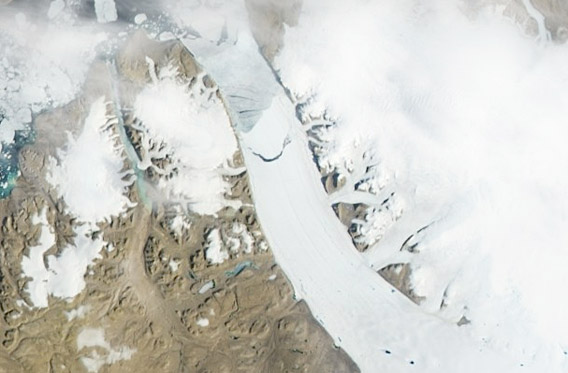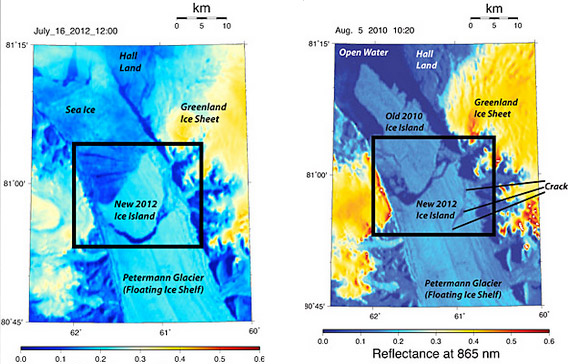 FNASA image showing the calving on the Petermann Glacier in northwestern Greenland |
A 119-square-kilometer (46-square-mile) iceberg twice the size of Manhattan has broken off Greenland’s Petermann Glacier, report researchers from the the University of Delaware and the Canadian Ice Service.
The break in the ice sheet, which has been anticipated for years, was detected Monday by the MODIS sensor onboard Terra and Aqua satellites. The iceberg was first reported by the Canadian Ice Service.
While large, the iceberg is only half the size of an ice island that broke off the same glacier in 2010. Nevertheless, the fracture is significant according to Andreas Muenchow, associate professor of physical ocean science and engineering at the the University of Delaware.
“While the size is not as spectacular as it was in 2010, the fact that it follows so closely to the 2010 event brings the glacier’s terminus to a location where it has not been for at least 150 years,” Muenchow said in a statement.
“The Greenland ice sheet as a whole is shrinking, melting and reducing in size as the result of globally changing air and ocean temperatures and associated changes in circulation patterns in both the ocean and atmosphere.”
 Left: the new ice island. Right: the ice island that calved from Petermann Glacier in 2010. The crack that led to the 2012 calving also is clearly visible. Courtesy of Andreas Muenchow, University of Delaware |
Muenchow added that the air around northern Greenland has warmed by about 0.11 degrees Celsius per year since 1987 — about five times faster than the global rate — although water temperatures have a stronger effect on the glacier. He said ocean temperature data for the region is still lacking.
The iceberg is expected to follow the same path as the 2010 berg, breaking up once it enters the Nares Strait, the channel between northern Greenland and Canada. The 2010 iceberg was the largest recorded in the region since 1962 when a 596-square-kilometer (230-square-mile) ice island calved from the Ward Hunt Ice Shelf on the northern coast of Ellesmere Island.
Related articles